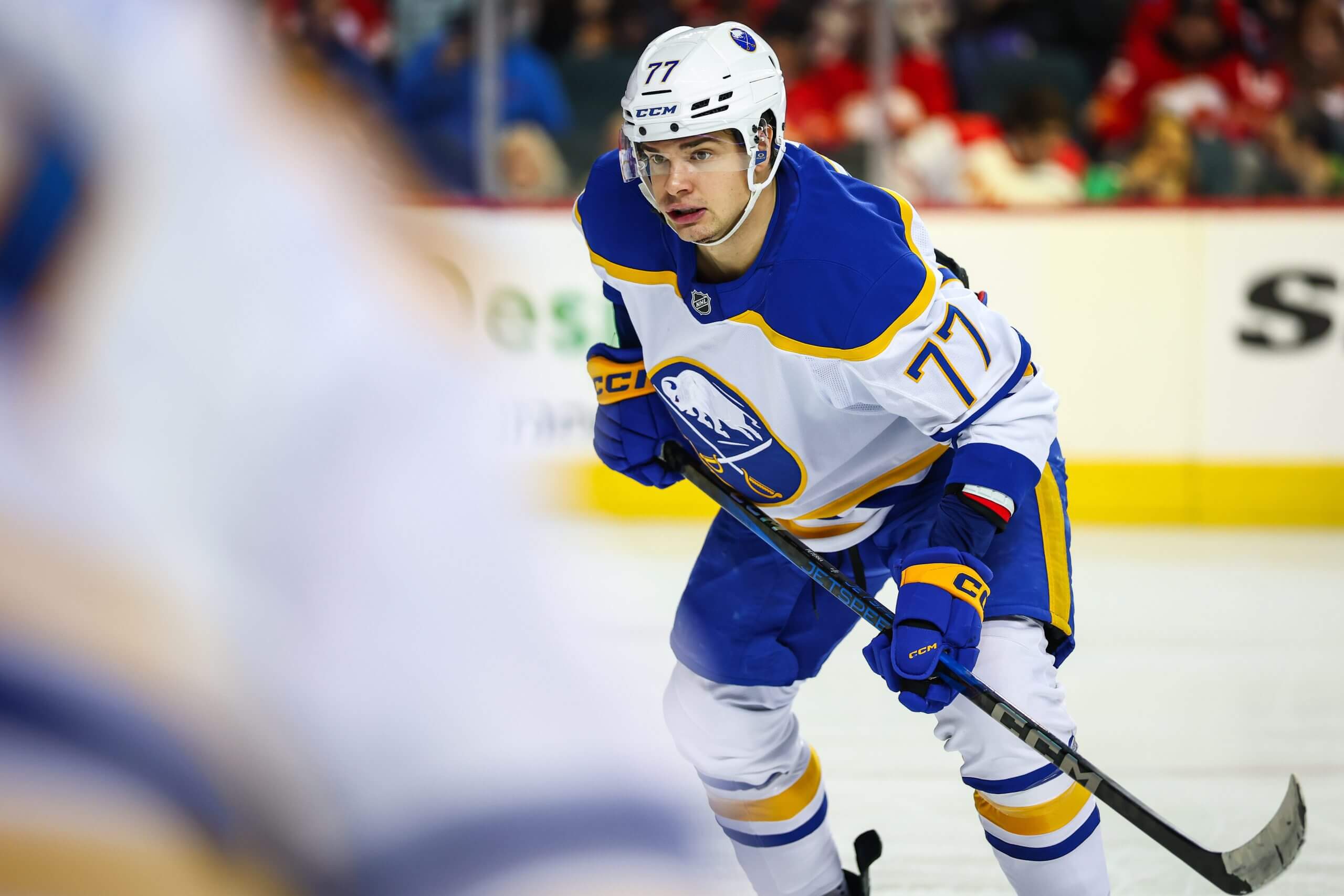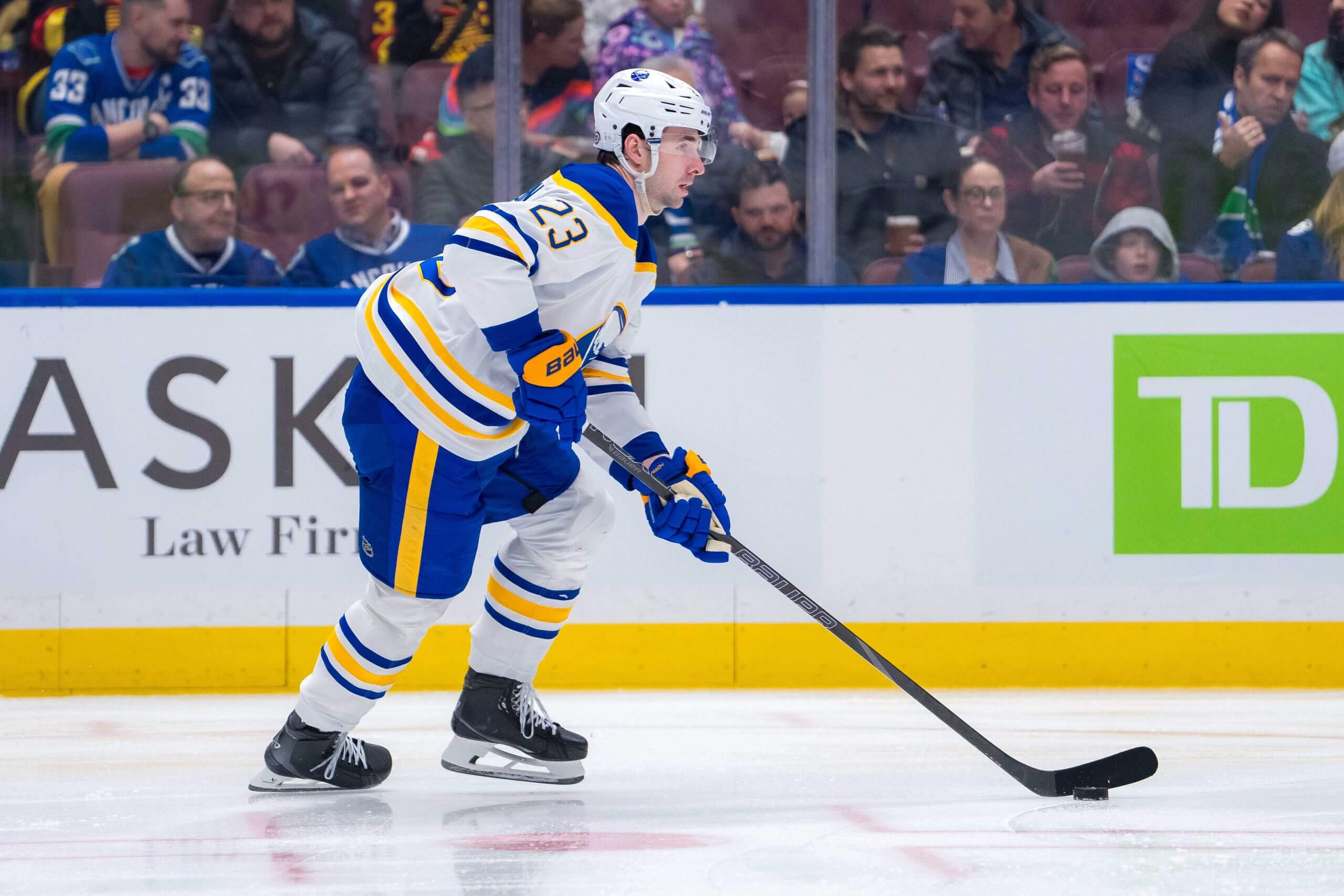Florida Panthers defenseman Nate Schmidt stood next to Sam Reinhart on the balcony of Elbo Room, a popular Fort Lauderdale bar, celebrating Florida’s second consecutive Stanley Cup win Thursday. A fan tossed Reinhart an old Buffalo Sabres Reinhart jersey to sign, which he did begrudgingly, but scoffed at the fan who tossed it.
Then Schmidt joined the fans in chanting, “Thank you, Buffalo!”
Reinhart, the second pick in the 2014 NHL Draft, played the first seven years of his career with the Sabres. In 2021, general manager Kevyn Adams traded him to the Panthers for a first-round pick that became Jiri Kulich and goalie prospect Devon Levi.
As an organization, the Sabres made multiple mistakes that led to the divorce with Reinhart. He always took a backseat to Jack Eichel, who was drafted with the No. 2 pick a year later. In 2018, then-general manager Jason Botterill gave Reinhart a two-year bridge contract when he was open to a long-term pact. Then, in 2020, with Adams freshly inserted as general manager, the Sabres signed Reinhart to a one-year contract that walked him to free agency.
By the time Adams got the job, most of the damage was done. Reinhart had a great year in 2020-21 and thrived under then-coach Don Granato late in the season. He scored at a 37-goal pace in that pandemic-shortened season. But he wasn’t willing to endure another rebuild and knew Eichel was as good as gone.
Eichel and Reinhart have both since won Stanley Cups with their new teams. Reinhart now has two after his four-goal game helped the Panthers finish off the Edmonton Oilers in Game 6 on Tuesday. He’s become an elite goal scorer, he finished in the top five of the Selke Trophy voting this season and, during a TNT Stanley Cup Final broadcast, Wayne Gretzky called him one of the smartest players to ever play the game.
That’s a lot for Sabres fans to stomach, particularly as Buffalo is stuck in a 14-year playoff drought. And it comes against the backdrop of another homegrown Sabre potentially playing elsewhere.
The JJ Peterka trade rumors got louder this week when Sportsnet’s Elliotte Friedman said the Sabres have been taking calls on the 23-year-old winger and he’s known to be unhappy in Buffalo. As we wrote after the NHL Scouting Combine, teams have been consistently calling the Sabres on Peterka, who is a restricted free agent. They haven’t been keen on trading him. But given the interest and demand, Adams needs to hear what’s out there.
Peterka, of course, is in a different situation from Reinhart. The Sabres have his rights for four more years before he’s an unrestricted free agent. And he’s not the same level of player as Reinhart, either. But the idea of another talented young player becoming disgruntled is the worst kind of deja vu for Sabres fans.

JJ Peterka had 68 points in 77 games for the Sabres last season. (Sergei Belski / Imagn Images)
1. The one question that matters when it comes to any possible Peterka trade: Can the Sabres make themselves better by trading him?
That’s the only way Adams should evaluate any proposals for Peterka. Future assets don’t matter unless packaged with pieces that can help the Sabres end the playoff drought next season. Peterka’s point production isn’t easy to replace, but the Sabres might be able to find a more complete two-way player in the process or shore up their hole at right defense. Maybe Peterka is valuable enough for them to accomplish both of those things in one trade.
2. There is a risk that the Sabres look like pushovers if they trade Peterka at the first sign of his dissatisfaction. With four years of team control, Adams has the leverage to play hardball. But that’s a delicate game to play in a locker room that has a lot of players frustrated with losing. Adams and Lindy Ruff spent a lot of time after the season talking about the need for the culture to change. A big part of that is having everyone pulling in the same direction. If Peterka is going to stay in Buffalo, Adams needs to make sure he’s bought in and will stay bought in as long as possible.
3. Peterka should also recognize that not every situation around the league will be as good for him as the one in Buffalo. He’s getting top-six minutes and top power-play usage. That’s a big reason he got 68 points last season and 50 the year before. Would he have that same role on every other team? I understand he wants to exercise some leverage here, but he has to think about the big picture, too. He’s four years away from unrestricted free agency. He has no trade protection. If he does end up getting traded, the Sabres don’t have to send him to a preferred destination. Buffalo isn’t a hockey paradise at the moment, but there are incentives for him to stick around.
4. One other factor tied to the Peterka decision is the development of Zach Benson. He’s entering his third season in the league and is only 20, but late in the season, we got a glimpse of what he could do when playing on a line with Tage Thompson.
Consider these stats courtesy of Natural Stat Trick:
• Benson and Thompson together at five-on-five: 53.85 percent expected goal share
• Benson without Thompson at five-on-five: 54.68 percent expected goal share
• Thompson without Benson: 51.05 percent expected goal share
• Peterka with Thompson together at five-on-five: 50.34 percent expected goal share
• Peterka without Thompson: 42.77 percent expected goal share
• Thompson without Peterka: 53.31 percent expected goal share
Thompson is Buffalo’s biggest driver among the forwards, so it’s no surprise Peterka was better when playing with him than without him. There is also a case to be made that playing well with Thompson is part of Peterka’s appeal.
But the Benson numbers are notable, even in a smaller sample size. You might be thinking, “That’s great, but Benson only had 28 points last season and 30 the year before. Peterka had 68 points last season and 50 the year before.” That’s valid, but there’s more to building a team than point totals. There is a benefit to building a line of players who complement one another. The way Benson forechecks, wins puck battles and gets to the net makes him a much different player than Peterka. He’s also far better defensively, which matters when playing with Thompson, who has defensive deficiencies of his own.
The Sabres may not even need Benson to fill that role if they trade Peterka. A 23-year-old with Peterka’s production over the last two seasons would net a significant return. There’s a good chance the Sabres could fill multiple holes in their lineup by moving him. But Benson’s value shouldn’t be overlooked because of a few mediocre point totals at 18 and 19 years old. He’s one of Buffalo’s best all-around forwards and still has the potential to become a 60-plus-point player.
5. What shouldn’t be lost in the Peterka distraction is that Alex Tuch needs to be a priority for the Sabres. He’s eligible for an extension on July 1, and they’ve already met with his agent to set the table for negotiations. This is Adams’ chance to show Tuch he’s ready to make a serious commitment to him financially and also that he’s capable of building a competitive team around him. Tuch isn’t just going to stick around because he grew up a Sabres fan.
6. In his latest mock draft, Corey Pronman has Boston College center James Hagens falling to No. 8 and Brampton winger Porter Martone falling to the Sabres at No. 9. If either player is available, Buffalo will be extremely fortunate. Hagens is a potential No. 1 center and would be a major value at No. 9. Martone’s size, competitiveness and goal-scoring touch around the net would also make him an easy pick for the Sabres if he falls. If you’re rooting for one of those two players to make it to No. 9, you want to hear names like Brady Martin, James O’Brien, Roger McQueen and Radim Mrtka in the top eight picks. If three of those players go in the top eight, it’s likely one of Hagens or Marton will be there for the Sabres. That’s a best-case scenario for Buffalo.

Mattias Samuelsson hasn’t lived up to his contract. (Bob Frid / Imagn Images)
7. The buyout window is officially open until June 30, and Mattias Samuelsson is the name to keep an eye on. He’s entering the third season of a contract that pays him $4.285 million annually. He turns 26 next season, so this is the Sabres’ last chance to buy him out at one-third of his total contract cost. He would count for $714,286 on the cap for the next 10 years if the Sabres bought him out. That would save Buffalo just over $3.5 million in each of the next five seasons, and they would then have a penalty of $714,286 for five years after that. The cost savings could come in handy as they try to fit their restricted free agents under the cap while leaving room to change the roster.
Samuelsson hasn’t lived up to the contract he signed. He’s struggled to stay healthy and struggled when he’s been healthy. Even after being named an alternate captain this season, Samuelsson got off to a slow start and was at the center of one of the team’s most disappointing moments of the season when nobody stepped in to defend Tage Thompson after a dirty hit from Stefan Noesen.
The Sabres should still take their time with this decision because they need to know what the rest of the blue line is going to look like. Defense is already a position that needs work, and Bowen Byram’s uncertain status as a restricted free agent further clouds the picture. By the time June 30 rolls around, the Sabres should have a better idea of where things stand with Byram and just how expendable Samuelsson is. The Sabres still believe in Samuelsson, but there’s no denying they could use that money.
(Top photo of JJ Peterka: Rebecca Villagracia / Getty Images)
